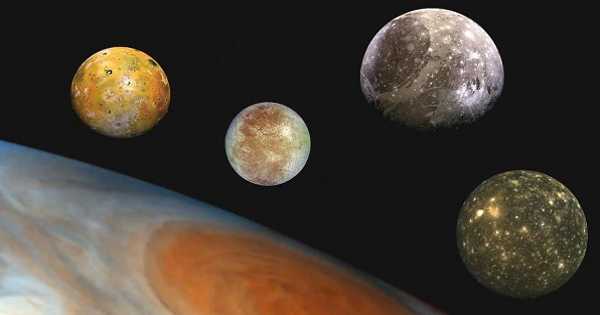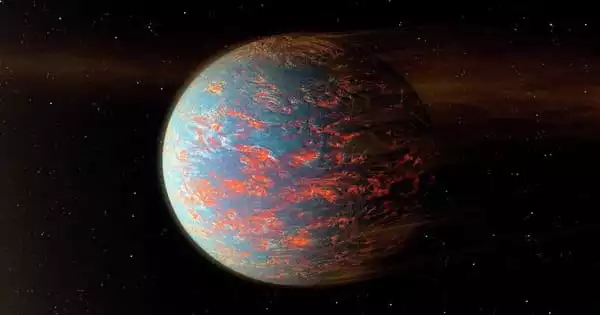Jupiter’s moons’ gravitational push and pull could account for more warming than the gas giant Jupiter alone. Jupiter’s moons are extremely hot. Jupiter’s well-known stripes and swirls are actually cold, windy clouds of ammonia and water floating in a hydrogen and helium-rich atmosphere. Jupiter’s famous Great Red Spot is a massive storm larger than Earth that has been raging for hundreds of years.
They’re hotter than they should be, given how far they are from the sun. Tidal heating occurs when gravitational tugs from Jupiter’s moons and the planet itself stretch and squish the moons enough to heat them. As a result, some of the icy moons have interiors warm enough to support oceans of liquid water, and tidal heating melts rock into magma on the rocky moon Io.
Previously, researchers thought that the gas giant Jupiter was responsible for the majority of the tidal heating associated with the liquid interiors of the moons, but a new study published in Geophysical Research Letters discovered that moon-moon interactions may be more responsible for the heating than Jupiter alone.
“It’s surprising because Jupiter’s moons are so much smaller. You wouldn’t think they’d be able to generate such a large tidal response “Hamish Hay, a postdoctoral fellow at the Jet Propulsion Laboratory in Pasadena, California, who conducted the research while a graduate student at the University of Arizona Lunar and Planetary Laboratory, is the paper’s lead author.
The gravitational push and pull by Jupiter’s moons could account for more warming than the gas giant Jupiter alone.
Understanding how the moons interact with one another is critical because it can shed light on the evolution of the moon system as a whole. Io, Europa, Ganymede, and Callisto are the four largest of Jupiter’s nearly 80 moons.
“Keeping subsurface oceans from freezing over geological time requires a fine balance between internal heating and heat loss, and yet we have several pieces of evidence that Europa, Ganymede, Callisto, and other moons should be ocean worlds,” said co-author Antony Trinh, a postdoctoral research fellow in the Lunar and Planetary Lab.
“Io, Jupiter’s closest moon, exhibits widespread volcanic activity, another result of tidal heating, but at a greater intensity than likely experienced by other terrestrial planets, such as Earth, in their early history. Finally, we want to understand the source of all this heat, both for its impact on the evolution and habitability of the solar system’s many worlds and beyond.”

Tidal Resonance
The secret to tidal heating is a phenomenon known as tidal resonance. “Resonance generates a lot more heating,” Hay explained. “Simply put, if you push an object or system and then release it, it will wobble at its own natural frequency. If you continue to push the system at the correct frequency, the oscillations grow larger and larger, just like when you push a swing. If you push the swing at the right time, it will go higher; however, if the timing is off, the swing’s motion will be dampened.”
The natural frequency of each moon is determined by the depth of its ocean. “These tidal resonances were known prior to this work, but only for Jupiter tides, which can only create this resonance effect if the ocean is really thin (less than 300 meters or under 1,000 feet),” Hay explained. “When tidal forces act on a global ocean, a tidal wave on the surface propagates around the equator with a certain frequency or period.”
According to the researchers’ model, Jupiter’s influence alone cannot produce tides of sufficient frequency to resonate with the moons because the oceans of the moons are thought to be too thick. It wasn’t until the researchers factored in the gravitational influence of the other moons that they noticed tidal forces approaching the moons’ natural frequencies.
When the tides generated by other objects in Jupiter’s moon system match each moon’s resonant frequency, the moon begins to experience more heating than that caused by Jupiter’s tides alone, and in the most extreme cases, this could result in the internal melting of ice or rock.
For moons to have tidal resonance, their oceans must be tens to hundreds of kilometers thick – at most a few hundred miles – which is within the range of current scientific estimates. However, the researchers’ findings are not without caveats.
According to Hay, their model assumes that tidal resonances never become too extreme. He and his team want to go back to this variable in the model and see what happens when that constraint is removed. Hay also hopes that future research will be able to determine the true depth of the oceans contained within these moons. NASA’s Habitable Worlds program provided funding for this research.
















